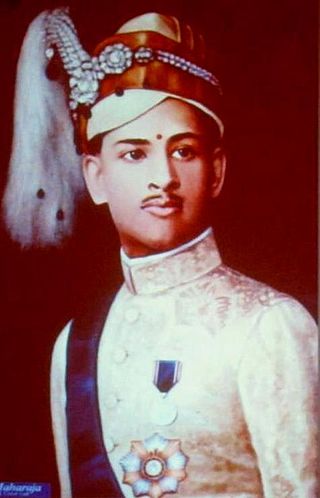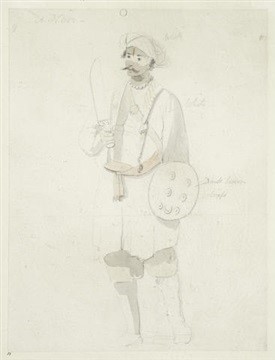
Kottayam is one of 14 districts in the Indian state of Kerala. Kottayam district comprises six municipal towns: Kottayam, Changanassery, Pala, Erattupetta, Ettumanoor, and Vaikom. It is the only district in Kerala that does not border the Arabian Sea or any other Indian state.

The Kingdom of Travancore, also known as the Kingdom of Thiruvithamkoor, was an Indian kingdom from c. 1729 until 1949. It was ruled by the Travancore Royal Family from Padmanabhapuram, and later Thiruvananthapuram. At its zenith, the kingdom covered most of the south of modern-day Kerala and the southernmost part of modern-day Tamil Nadu with the Thachudaya Kaimal's enclave of Irinjalakuda Koodalmanikyam temple in the neighbouring Kingdom of Cochin. However Tangasseri area of Kollam city and Anchuthengu near Attingal in Thiruvananthapuram were parts of British India.

Sree Padmanabhadasa Sree Chithira Thirunal Balarama Varma, popularly known as Sree Chithira Thirunal, was the last ruling Maharaja of the Indian princely state of Travancore, in southern India until 1949 and later the Titular Maharajah of Travancore until 1991. His reign is known for several notable reforms that have indelible impact on the society and culture of Kerala.

Idukki is one of the 14 districts in the Indian state of Kerala in the southwest of the country. It is the largest district in Kerala and lies amid the Cardamom Hills of Western Ghats in Kerala. Idukki district contains two municipal towns - Kattappana and Thodupuzha, and five taluks.

The Kingdom of Cochin, named after its capital in the city of Kochi (Cochin), was a kingdom in the central part of present-day Kerala state. It commenced at the early part of the 12th century and continued to rule until 1949, when the monarchy was abolished by the Dominion of India.

Travancore–Cochin, or Thiru–Kochi, was a short-lived state of India (1949–1956). It was originally called United State of Travancore and Cochin following the merger of two former kingdoms, Travancore and Cochin on 1 July 1949. Its original capital was Thiruvananthapuram. It was renamed State of Travancore–Cochin in January 1950. Travancore merged with erstwhile princely state of Cochin to form Travancore–Cochin in 1950. The five Tamil-majority Taluks of Vilavancode, Kalkulam, Thovalai, Agastheeswaram, and Sengottai were transferred from Travancore-Cochin to Madras State in 1956. The Malayalam-speaking regions of the Travancore–Cochin merged with the Malabar District and the Kasaragod Taluk of South Canara district in Madras State to form the modern Malayalam-state of Kerala on 1 November 1956, according to the States Reorganisation Act, 1956 passed by the Government of India.

The Nair also known as Nayar, are a group of Indian Hindu castes, described by anthropologist Kathleen Gough as "not a unitary group but a named category of castes". The Nair include several castes and many subdivisions, not all of whom historically bore the name 'Nair'. These people lived, and continue to live, in the area which is now the Indian state of Kerala. Their internal caste behaviours and systems are markedly different between the people in the northern and southern sections of the area, although there is not very much reliable information on those inhabiting the north.

Velayudhan Chempakaraman Thampi ofThalakulam (1765–1809) was the Dalawa or Prime Minister of the Indian kingdom of Travancore between 1802 and 1809 during the reign of Bala Rama Varma Kulasekhara Perumal. He is best known for being one of the earliest individuals to rebel against the British East India Company's authority in India.
Jenmi or Janmi, plural Jenmimar, is the Malayalam term used to refer to the landed aristocracy of Kerala who traditionally held their lands as absolute and allodial owners, with such lands known as Jenmom or Janmam. They formed the landowning nobility as well as the landed gentry of the region in colonial times, and the majority of the estates and feudal properties were owned by this community. They predominantly belonged to the Nambudiri and Nair castes.

The Nair Brigade was the army of the erstwhile kingdom of Travancore in India. Nairs were a warrior community of the region. The personal bodyguard of the king Marthanda Varma (1706–1758) was also called Thiruvithamkoor Nair Pattalam. The Travancore army was officially referred as the Travancore Nair Brigade in 1818.

The Ezhavas are a community with origins in the region of India presently known as Kerala, where in the 2010s they constituted about 23% of the population and were reported to be the largest Hindu community. The Malabar Ezhava group have claimed a higher ranking in the Hindu caste system than do the others, although from the perspective of the colonial and subsequent administrations they were treated as being of similar rank.
The Samantha Kshatriya are a community of Kerala, India. They were historically ruling elites and feudal aristocrats in the Kingdom of Cochin and Kingdom of Travancore. Despite their nomenclature suggesting that they are a part of the Kshatriya class in the Hindu ritual ranking system known as varna, that system has never existed in South India. Anthropologist Christopher Fuller, suggests such claims are vanity and that "most unbiased observers ... have concluded that the Kshatriya and Samanthan subdivisions should be treated merely as supereminent Nayar (Nair) subdivisions". The notable exception to that scholarly consensus is the sociologist Louis Dumont.
Devaswom are socio-religious trusts in India, whose members are nominated by the government and community. They oversee Hindu temples and their assets to ensure their smooth operation in accordance with traditional rituals and customs. The devaswom system notably exists in the state of Kerala, where most temples are either managed by Government of Kerala-controlled devaswoms or private bodies or families. The properties of each temple are deemed to be the personal property of the presiding deity of the temple, and are managed through a body of trustees who bear allegiance to that deity.

The Emblem of Kerala used by Government of Kerala, to represent the state in all its official correspondences. The emblem portrays two elephants guarding the state emblem of India and the Shankh of Sri Padmanabhaswamy according to the history of Kerala.

Kiryathil Nair or Kiriyath Nair is a Kshatriya subdivison of Nair caste, of martial nobility, having performed the functions of Kshatriyas in Kerala, India. This subcaste was among the highest-ranking subcastes of the Nair community along with Samantan Nairs with whom they share a close history. They constituted the ruling elites (Naduvazhi) and feudal aristocrats (Jenmimar) in the regions of Malabar and Cochin in present-day Kerala, India, and have traditionally lived in ancestral homes known as Tharavads and Kovilakams.
Madampi(equivalent to Lord in English) is an aristocratic title given to the uppermost subdivisions of Nairs in Kerala, by the Maharajahs of Travancore and Cochin. Usually, it was given in addition to the Pillai title. Madampis served as Jenmis or landlords during the pre-independence era. Their power was severely reduced after the Communist government passed the Land Reforms Ordinance. The title Madampi was also used in Cochin, to denote the 71 Nayar chiefs who ruled under the Maharajah of Cochin. A few Nambuthiri landlord families, most notable of whom being those in Vanjipuzha and Makilanjeri, were also given the Madampi title. In Cochin, the Madampis had their own armies, but seldom numbered more than 100. Their power was only a little bit higher than that of the Desavazhis. Madampis supplied chieftains along with soldiers in times of war to the King.
The Cochin Legislative Council was a unicameral legislative body of the Cochin State that functioned from 1925 to 1948 before the merger of Cochin and Travancore to form the Travancore–Cochin state and the Travancore–Cochin Legislative Assembly.











